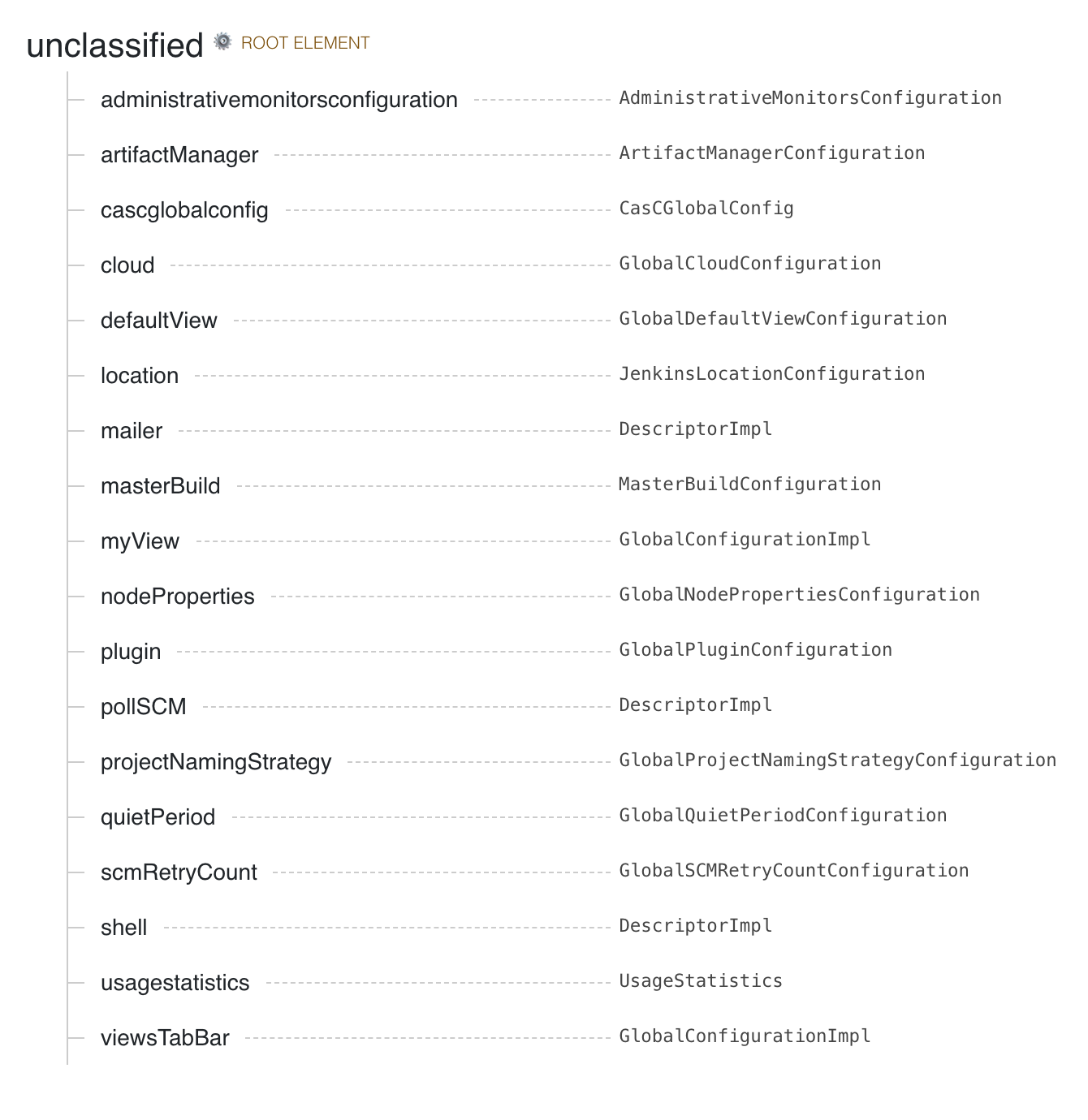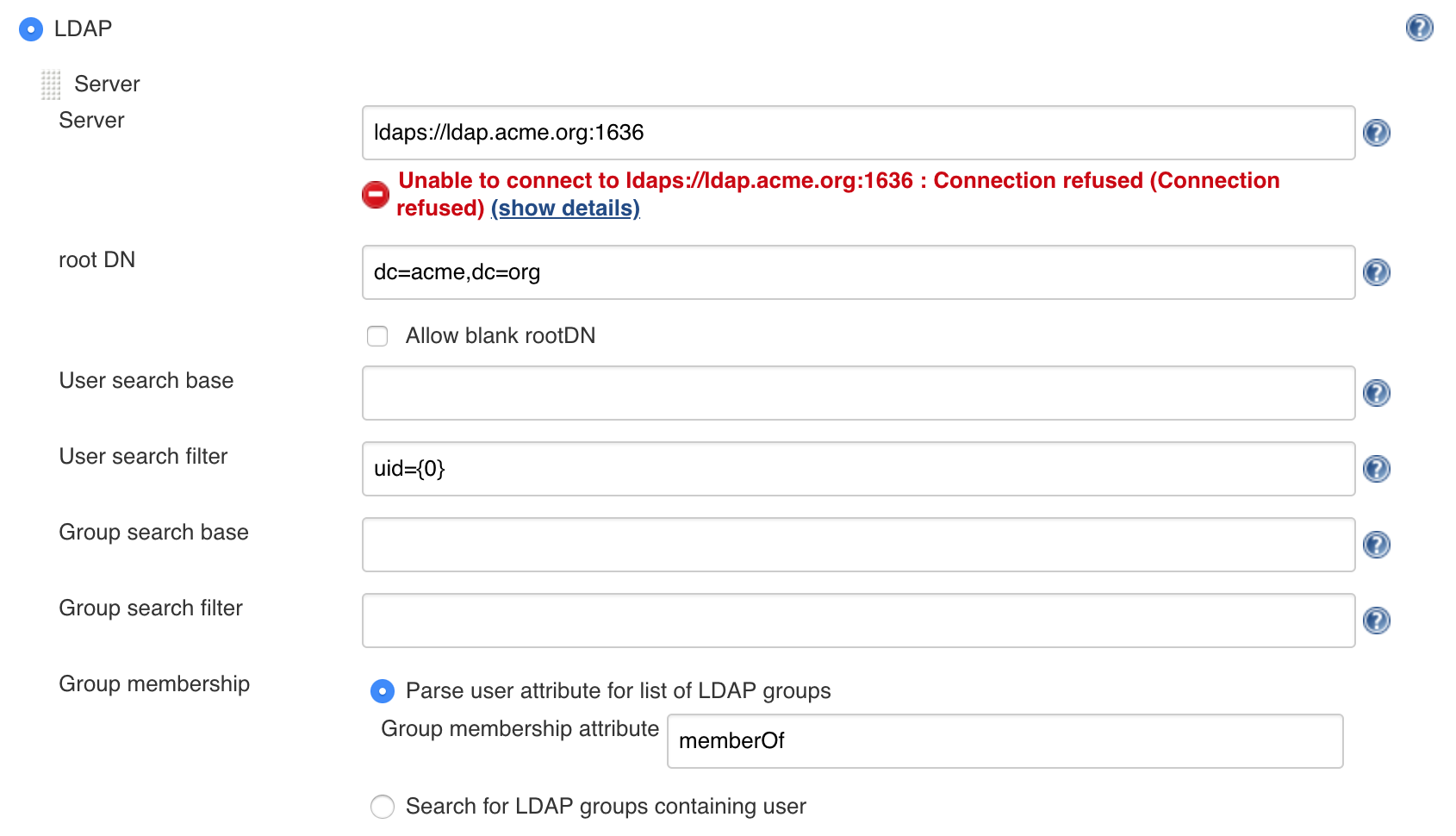- Introduction
- Getting Started
- Examples and demos
- Handling Secrets
- Security considerations
- Exporting configurations
- Validating configurations
- Merge Strategy
- Triggering Configuration Reload
- Installing plugins
- Supported Plugins
- Adding JCasC support to a plugin
- Configuration-as-Code extension plugins
- Jenkins Enhancement Proposal
Setting up Jenkins is a complex process, as both Jenkins and its plugins require some tuning and configuration, with dozens of parameters to set within the web UI manage section.
Experienced Jenkins users rely on groovy init scripts to customize Jenkins and enforce the desired state. Those scripts directly invoke Jenkins API and, as such, can do everything (at your own risk). But they also require you to know Jenkins internals and are confident in writing groovy scripts on top of Jenkins API.
The Configuration as Code plugin is an opinionated way to configure Jenkins based on human-readable declarative configuration files. Writing such a file should be feasible without being a Jenkins expert, just translating into code a configuration process one is used to executing in the web UI.
The below configuration file includes root entries for various components of your primary Jenkins installation. The jenkins one is for the root Jenkins object, and the other ones are for different global configuration elements.
jenkins:
systemMessage: "Jenkins configured automatically by Jenkins Configuration as Code plugin\n\n"
globalNodeProperties:
- envVars:
env:
- key: VARIABLE1
value: foo
- key: VARIABLE2
value: bar
securityRealm:
ldap:
configurations:
- groupMembershipStrategy:
fromUserRecord:
attributeName: "memberOf"
inhibitInferRootDN: false
rootDN: "dc=acme,dc=org"
server: "ldaps://ldap.acme.org:1636"
nodes:
- permanent:
name: "static-agent"
remoteFS: "/home/jenkins"
launcher:
inbound:
workDirSettings:
disabled: true
failIfWorkDirIsMissing: false
internalDir: "remoting"
workDirPath: "/tmp"
slaveAgentPort: 50000
tool:
git:
installations:
- name: git
home: /usr/local/bin/git
credentials:
system:
domainCredentials:
- credentials:
- basicSSHUserPrivateKey:
scope: SYSTEM
id: ssh_with_passphrase_provided
username: ssh_root
passphrase: ${SSH_KEY_PASSWORD}
description: "SSH passphrase with private key file. Private key provided"
privateKeySource:
directEntry:
privateKey: ${SSH_PRIVATE_KEY}
Additionally, we want to have a well-documented syntax file and tooling to assist in writing and testing, so end users have full guidance in using this toolset and do not have to search for examples on the Internet.
See the presentation slides from DevOps World - Jenkins World 2018 for an overview.
First, start a Jenkins instance with the Configuration as Code plugin installed.
- Those running Jenkins as a Docker container (and maybe also pre-installing plugins), do include Configuration as Code plugin.
Second, the plugin looks for the CASC_JENKINS_CONFIG environment variable. The variable points to a comma-separated list of any of the following:
- Path to a folder containing a set of config files. For example,
/var/jenkins_home/casc_configs. - A full path to a single file. For example,
/var/jenkins_home/casc_configs/jenkins.yaml. - A URL pointing to a file served on the web. For example,
https://acme.org/jenkins.yaml.
If an element of CASC_JENKINS_CONFIG points to a folder, the plugin will recursively traverse the folder to find file(s) with .yml,.yaml,.YAML,.YML suffix. It will exclude hidden files or files that contain a hidden folder in any part of the full path. It follows symbolic links for both files and directories.
Exclusion examples
CASC_JENKINS_CONFIG=/jenkins/casc_configs
✔️ /jenkins/casc_configs/jenkins.yaml
✔️ /jenkins/casc_configs/dir1/config.yaml
❌ /jenkins/casc_configs/.dir1/config.yaml
❌ /jenkins/casc_configs/..dir2/config.yaml
CASC_JENKINS_CONFIG=/jenkins/.configs/casc_configs contains hidden folder .config
❌ /jenkins/.configs/casc_configs/jenkins.yaml
❌ /jenkins/.configs/casc_configs/dir1/config.yaml
❌ /jenkins/.configs/casc_configs/.dir1/config.yaml
❌ /jenkins/.configs/casc_configs/..dir2/config.yaml
All configuration files that are discovered MUST be supplementary. They cannot overwrite each other's configuration values. This creates a conflict and raises a ConfiguratorException. Thus, the order of traversal does not matter to the final outcome.
Instead of setting the CASC_JENKINS_CONFIG environment variable, you can also define using the casc.jenkins.config Java property. This is useful when installing Jenkins via a package management tool and can't set an environment variable outside of a package-managed file, which could be overwritten by an update. For RHEL/CentOS systems, you can append the following to the JENKINS_JAVA_OPTIONS entry in /etc/sysconfig/jenkins
-Dcasc.jenkins.config=/jenkins/casc_configs
If you do not set the CASC_JENKINS_CONFIG environment variable or the casc.jenkins.config Java property, the plugin will default to looking for a single config file in $JENKINS_HOME/jenkins.yaml.
If set up correctly, you should be able to browse the Configuration as Code page Manage Jenkins -> Configuration as Code.
When configuring the first Jenkins instance, browse the examples shown in the demos directory of this repository. If you have a plugin that does not have an example, consult the reference help document. Click the Documentation link at the bottom of the Configuration as Code page in your Jenkins instance.
If you want to configure a specific plugin, search the page for the name of the plugin. The page will show you which root element belongs to the configuration. Most installed plugins belong under the unclassified root element.
See demos folder with various samples.
Replace user interface based configuration for LDAP with the text-based configuration.
jenkins:
securityRealm:
ldap:
configurations:
- groupMembershipStrategy:
fromUserRecord:
attributeName: "memberOf"
inhibitInferRootDN: false
rootDN: "dc=acme,dc=org"
server: "ldaps://ldap.acme.org:1636"
Replace repeated elements with yaml anchors. Anchor keys must be prefixed with x- due to JCasC handling unknown root elements.
x-jenkins-linux-node: &jenkins_linux_node_anchor
remoteFS: "/home/jenkins"
launcher:
inbound:
workDirSettings:
disabled: true
failIfWorkDirIsMissing: false
internalDir: "remoting"
workDirPath: "/tmp"
jenkins:
nodes:
- permanent:
name: "static-agent1"
<<: *jenkins_linux_node_anchor
- permanent:
name: "static-agent2"
<<: *jenkins_linux_node_anchor
Which produces two permanent agent nodes which can also be written like this.
jenkins:
nodes:
- permanent:
name: "static-agent1"
remoteFS: "/home/jenkins"
launcher:
inbound:
workDirSettings:
disabled: true
failIfWorkDirIsMissing: false
internalDir: "remoting"
workDirPath: "/tmp"
- permanent:
name: "static-agent2"
remoteFS: "/home/jenkins"
launcher:
inbound:
workDirSettings:
disabled: true
failIfWorkDirIsMissing: false
internalDir: "remoting"
workDirPath: "/tmp"
Only Jenkins administrators are able to create or update a Jenkins instance using configuration as code configuration files. However, in some environments, administrators may choose to allow less privileged users to modify portions of the configuration files, for example by storing them in an SCM repository that those users have access to. Allowing non-administrators to edit these configuration files can pose various security risks, so any changes made by non-administrators must be reviewed for safety before they are applied.
Here are some examples of changes that could be problematic:
- Modification of the security realm or authorization strategy settings could give users higher permissions than intended.
- Interpolation of secrets in unprotected contexts may expose sensitive data. For example, a snippet like
systemMessage: "${SENSITIVE_VARIABLE}"could expose the value of a sensitive environment variable to all users who are able to access Jenkins.
We don't support installing plugins with JCasC, so you need to use something else for this,
Dockers users can use:
https://github.com/jenkinsci/docker/#preinstalling-plugins
Kubernetes users:
https://github.com/jenkinsci/helm-charts
Most plugins should be supported out-of-the-box or maybe require some minimal changes. See this dashboard for known compatibility issues.
Plugin developers wanting to support JCasC in their plugin should check out our how-to guide.
- configuration-as-code-groovy-plugin
Allows specifying groovy code that should run on during configuration.
As configuration as code is demonstrated to be a highly requested topic in the Jenkins community, we have published JEP 201 as a proposal to make this a standard component of the Jenkins project. The proposal was accepted. 🎉







